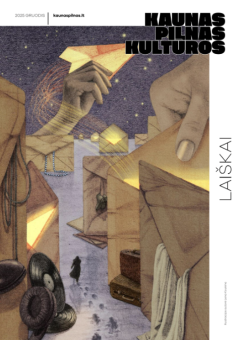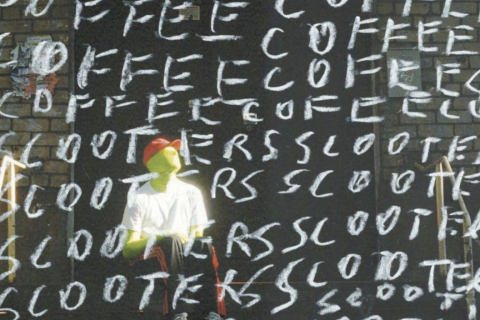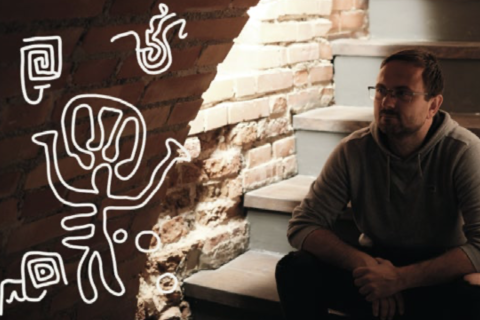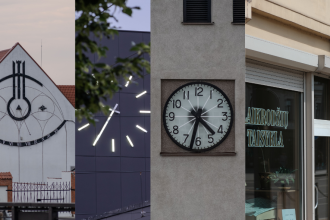“Watch out for the car”
This road sign greets me as I cycle from Lapės to Kaunas. It stands on Panerių Street… My tongue itches to say, “at the beginning,” but the street numbering suggests that I still have a few more kilometers to pedal. I check to make sure: about four kilometers. After covering that distance, I discovered that Paneriai Street actually begins with a pharmacy that opened in 1936, a garage, and a Žalgiris fan graffiti painted on a silicate brick wall.
(Text published in the July 2025 issue of Kaunas Full of Culture magazine)
Only later, after I’ve already decided that Panerių Street will mark the beginning of this slow, independent, experimental tour, do I learn that the pedestrian crossing at the other end of the street, next to the vegetarian restaurant Ganga, is connected to that very first road sign I saw.
As my friend who grew up nearby told me, the pedestrian crossing was installed when an elderly woman was hit – and later died – by a young car driver who was distracted by a pretty girl.
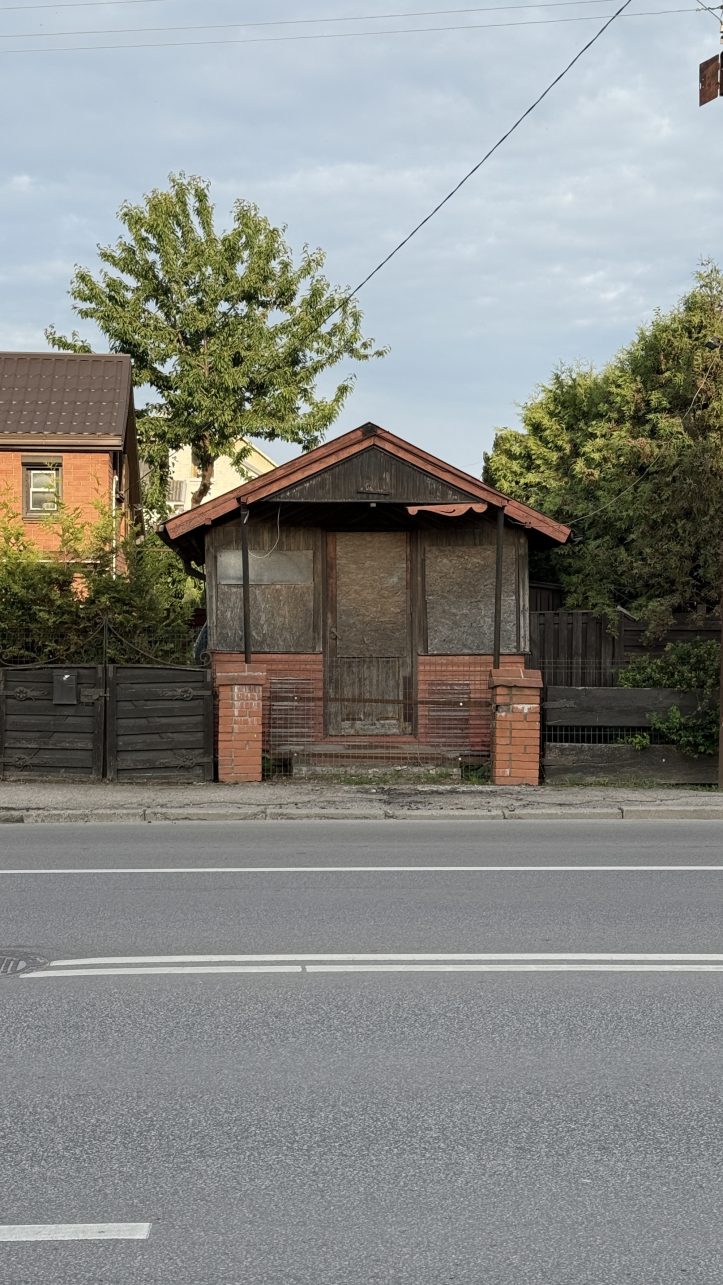
It’s worth noting that Panerių Street holds more than just one painful chapter of history. It ran through the Kaunas Ghetto, and Jews confined to the ghetto were not allowed to walk along it, as it was a road leading from Kaunas to other cities. It was right near this street, in Demokratų Square, that the Great Action began on October 29, 1941. It ended at the Ninth Fort, where more than 9,000 Jews were murdered in a single day.
There are few traces of these stories on the street today. On quiet summer evenings, there are only a few passersby. Everyone is either in their cars or at home. Perhaps the blame lies with the indescribable condition of Panerių Street’s sidewalks. Dogs bark, but only behind fences. That’s a good sign for those who, like me, have chosen to take this slow route by bike. One evening, then the next, and finally in the morning. I’ll try to break down my slow experience into a few chapters.
Architecture
Panerių Street is old. This is hinted at by the name of one of the small streets that crosses it: Radvilų Dvaro Street (Radvila Manor Street). A tall chimney standing further down serves as a reminder of a brewery that operated here back in the 19th century, the story of which continues to bubble today near the Kaunas railway station.
The architectural diversity of the street is unique. From extremely worn-down wooden houses to the most striking examples of “collective farm baroque”, surrounded by massive thuja bushes or equally impressive fences. There are especially many homestead-style plots. The fences, by the way, come in all shapes and styles – practically a showcase of a hardware store. As far as the architecture of Panerių Street is concerned, it must be clearly divided into two parts. The first is Panerių Street from its beginning, Jurbarko Street, to Varnių Street and Milikonių Hill. Then from here to the end of the city, one could say, to the “watch out for the car” sign.
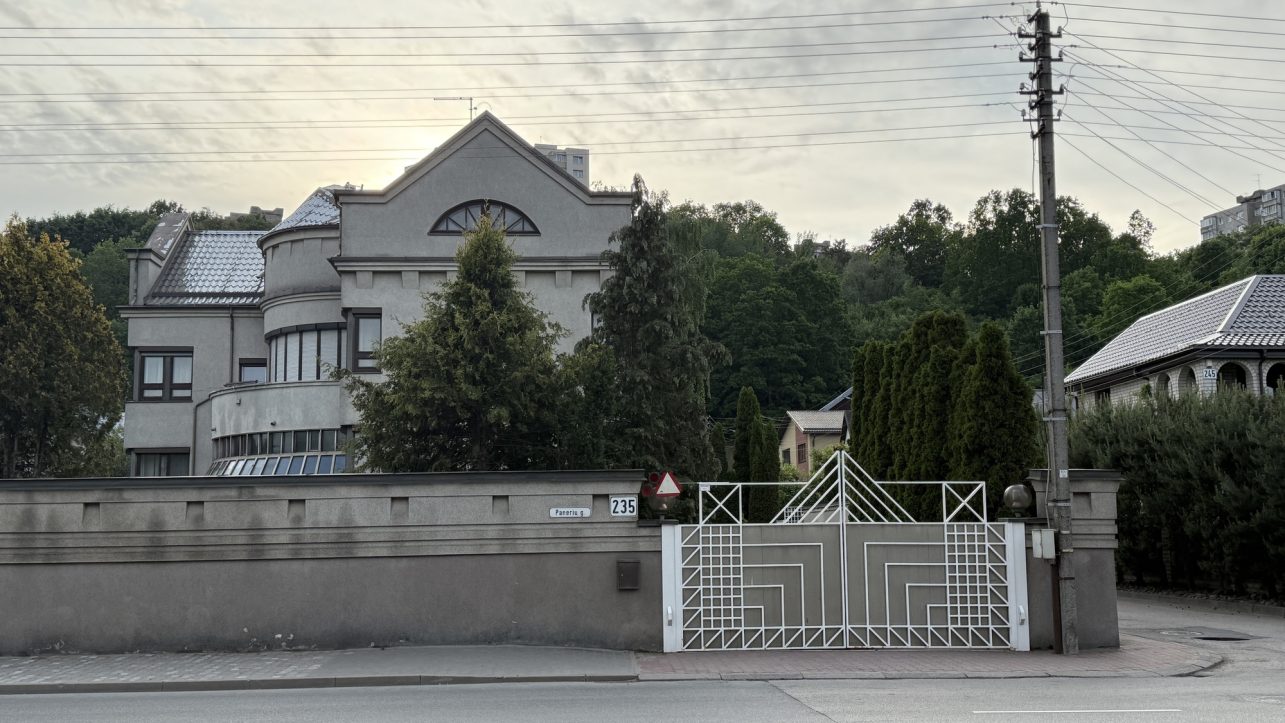
The section from Jurbarko Street to Varnių Street is much more diverse. Here, in addition to examples of residential architecture, you’ll find Soviet-era prefabricated apartment blocks and interwar period buildings. For example, there’s a yeshiva (a Jewish religious seminary) that was built before World War II but never completed. The original yeshiva had been nearby since the 19th century, and Jews began settling more densely in Vilijampolė from the first half of the 18th century. Not far from Panerių Street, you can also find a now-closed Jewish cemetery.
The new, unfinished yeshiva today is nearly unrecognizable and unmarked. There are also early post-war modernist houses, and – on the side streets – so-called “half-houses” that were studied by artist Inga Navickaitė-Drąsutė (her research was published as a separate album).
Meanwhile, the section from Varnių Street to the city’s edge was almost entirely undeveloped until after the war. The small streets that intersect it bear pagan names and, like the “shores” of Šančiai flowing into the Nemunas River, converge at the slope of Milikonių Hill. This makes the dead-end paths into safe spaces for children to play – I have seen more than one of these.
The neighborhood stretching from this part of Panerių Street toward the city center carries a kind of resort-like atmosphere. There’s even a guesthouse called Regina, richly adorned with blooming plants. The towering pines on Lampėdžių Street, taller than five-story buildings, evoke memories of Kulautuva, to say the least. Of course, the emotional tone of my experience is heightened by the golden light of a June evening.
Gastronomy
Satiety is an important attribute of any excursion. Of course, I wouldn’t recommend starting a walk on a full stomach, but you shouldn’t leave Panerių Street feeling very hungry either.
The small vegetarian restaurant Ganga and the nearby Kaunas Vedic Culture Center take care of the hungry and invite people to have lunch for a donation. The same acquaintance who told me the story about the pedestrian crossing also added that her aunt – a very wealthy and (perhaps because of that) very frugal woman – used to love dining here. But the history is silent about her offerings to Krishna and the other gods.
If you’re a traveler who avoids luxury (or simply forgot your water bottle), you’ll be pleased to know that near Ganga there’s a grocery store called Express Market, where – as in the rest of the chain – you can shop with your pets.
At the intersection of Varnių and Panerių streets, options begin to multiply. Here you’ll find a café-bar called Vyšnelė (Little Cherry), immortalized in a musical performance by actor Dominykas Vaitiekūnas, which tells the story of his aunt who founded the place. If you take a break on the terrace, your travel secrets will be shielded from passersby by dense bushes.
For the past seven years, a flower shop that stays open quite late has also operated at this intersection. What does this have to do with gastronomy, you ask? Well, it replaced the ravens that used to be here. If you grew up in Vilijampolė, Šilainiai, or simply enjoy reading the crime pages of newspapers, you probably know what ravens are.
Technically already on Varnių Street, but right next to the intersection – so it’s worth including among the stops on this tour – you will find a pastry shop Alkava, which, since 1994 has grown from a one-story house into a real macaroon and cake empire. Alkava is a great example of Kaunas-style entrepreneurship and resilience against chain stores and fleeting trends. Nearby, you’ll also find the noteworthy Chinese restaurant Sunya, which relocated here from the other side of Kaunas.
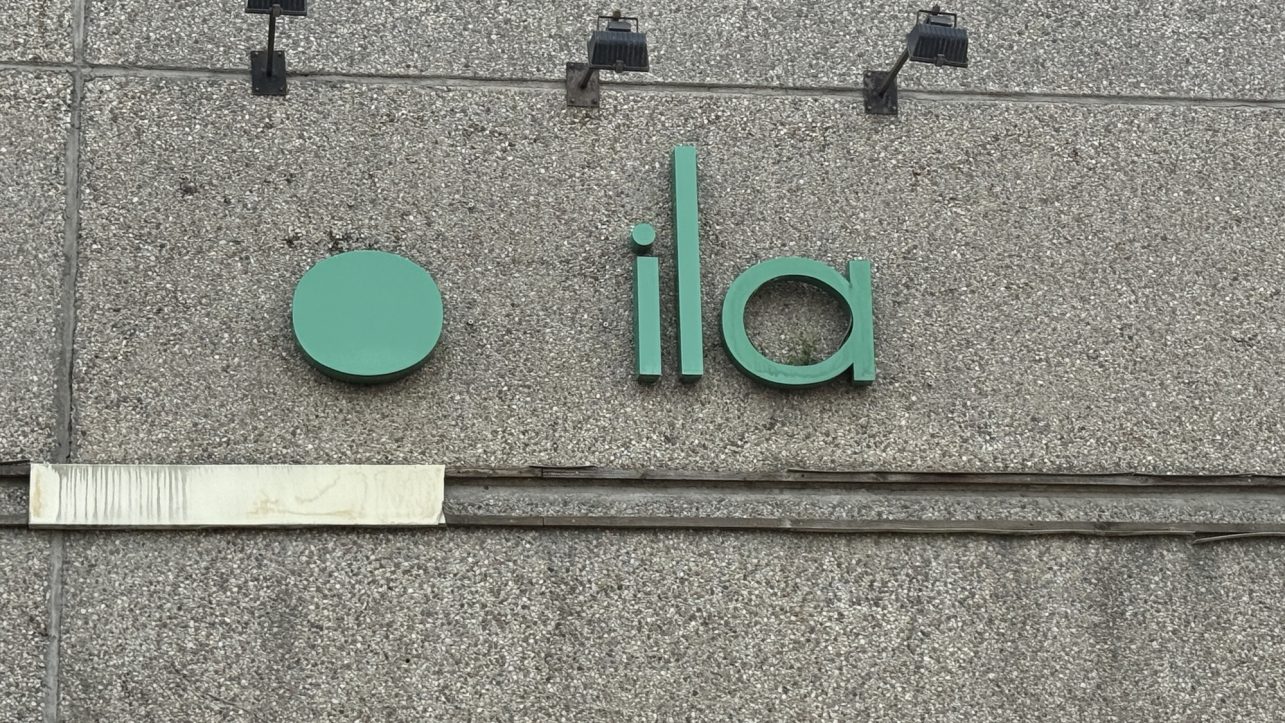
Continuing along Panerių Street, you can stop near the aforementioned yeshiva and the Dobilas textile factory, founded in 1925 but recently bankrupted (a nearby kindergarten named Dobiliukas still operates). Unsurprisingly, the factory is now being transformed into lofts and studios. Be sure to check out the small kiosk Lapė snapė, offering šimtalapis pastries and other treats. And if you’re craving something even sweeter, just around the corner on Linkuvos Street, you will find a handmade chocolate workshop La Roche.
Near Lapė snapė, you’ll also find a branch of the Kaunas-based grocery store chain Šilas. Right next to it is the chain’s production facility, which means the potato salad sold in this store should be fairly fresh.
Spiritual matters
Once again, I must mention Ganga and its religious attributes of vegetarian food. Of course, you can enjoy it without spiritual motives. On the other side of Varnių Street stands a much more prominent spiritual landmark: the Church of St. Joseph. It’s interesting to consider how the parishioners and the parish priest Juozapas Dagilis – who was a member of the Second Seimas and oversaw the church’s construction, designed by Karolis Reisonas, and worked here until 1944 – responded during World War II when they witnessed the tragedy unfolding in the Kaunas Ghetto. I wasn’t able to find any information about that. However, I did learn that during the Soviet occupation, part of the churchyard was confiscated, and the Vilnis cinema was built next door. Today, the gracefully shaped building houses a funeral home – the wheel of history turns.
Another interesting expression of Catholicism is revealed quite nearby, on a plot on Linkuvos Street (better seen from Koklių Street) in the form of the Chapel of the Blessed Virgin Mary of Lithuanian Freedom. Although its architectural forms resemble those of St. Joseph’s Church, it was built only in 1994. The chapel, designed by Liudvikas Aksamitauskas, stands on the plot owned by Juozas and Stefanija Stašauskas. Roses still grow there, recalling the owner, Stefanija, who was called the queen of roses. It is said that Juozas Stašauskas recovered when his wife prayed at a statue of Mary brought from Poland. In gratitude, S. Stašauskienė, together with priest Alfonsas Bulotas, decided to build a chapel dedicated to Lithuanian freedom in their yard. By the way, A. Bulotas held a mass in this chapel for the conversion of prosecutors in the Drąsius Kedys case.
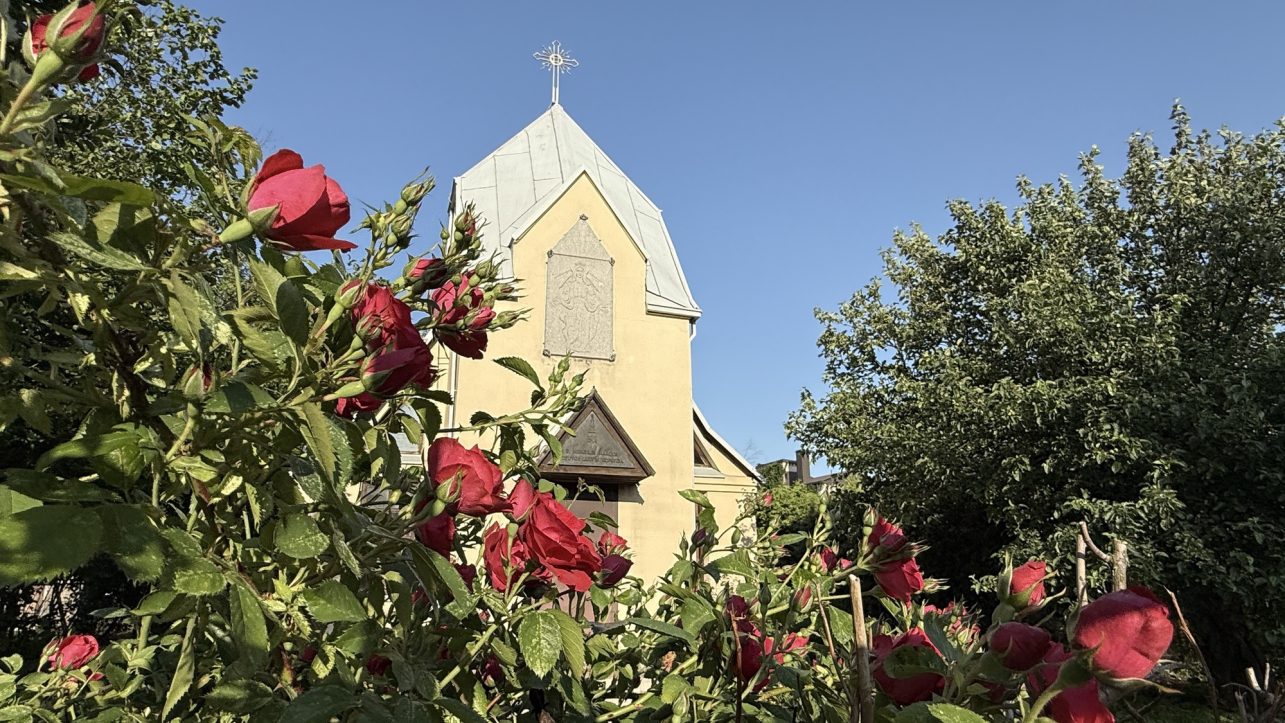
Another spiritual stop is right at the very beginning of Panerių Street. The house is small and painted in pastel shades, so it’s easy to miss; you’ll likely notice only the memorial plaque (which is rare in these neighborhoods compared to, say, the Radio district in Žaliakalnis). Right next to it is a small square, and in it, a stone that has become a memorial to Romas Kalanta. I think it’s important to see where the young man who could no longer bear to live under Soviet oppression and found himself in the City Garden in May 1972, came from.
Interesting facts
What kind of tour would it be without some spicy little details that help participants relax and connect historical stories with a wealth of facts? Panerių Street (and the streets crossing it) definitely has plenty of such details.
For example, I really like people who, living on the ground floors, understand their responsibility for the experience they create for passersby at their windowsills – not just pulling down the blinds, but making an effort to create small secret rooms. There are plenty of such “windowsill showcases” on Panerių Street.
Another curious thing is yard decorations. I found some of the most interesting ones at the beginning of the street from Varnių toward Lapių Street. A young man I met explained that the metal sculpture resembling Vytis (there were two, but one was stolen) and some ceramic wayside shrines I hadn’t seen before were created by his great-grandfather, Mickevičius. On the other side of the street, another interesting creature lurks – neither a dragon nor a unicorn.
The details of the aforementioned “collective farm baroque” are rather interesting as well. However, entire layers of mysteries, unseen in any official story about Kaunas, reveal themselves when you decide to explore the small streets near the Jurbarko Street roundabout. Trails untouched by asphalt, no sidewalks, architecture patched together from several eras (and found building materials), one of the oldest pharmacies in Kaunas (with interesting plants and interior no less fascinating than its pills and tablets), and many other surprises.
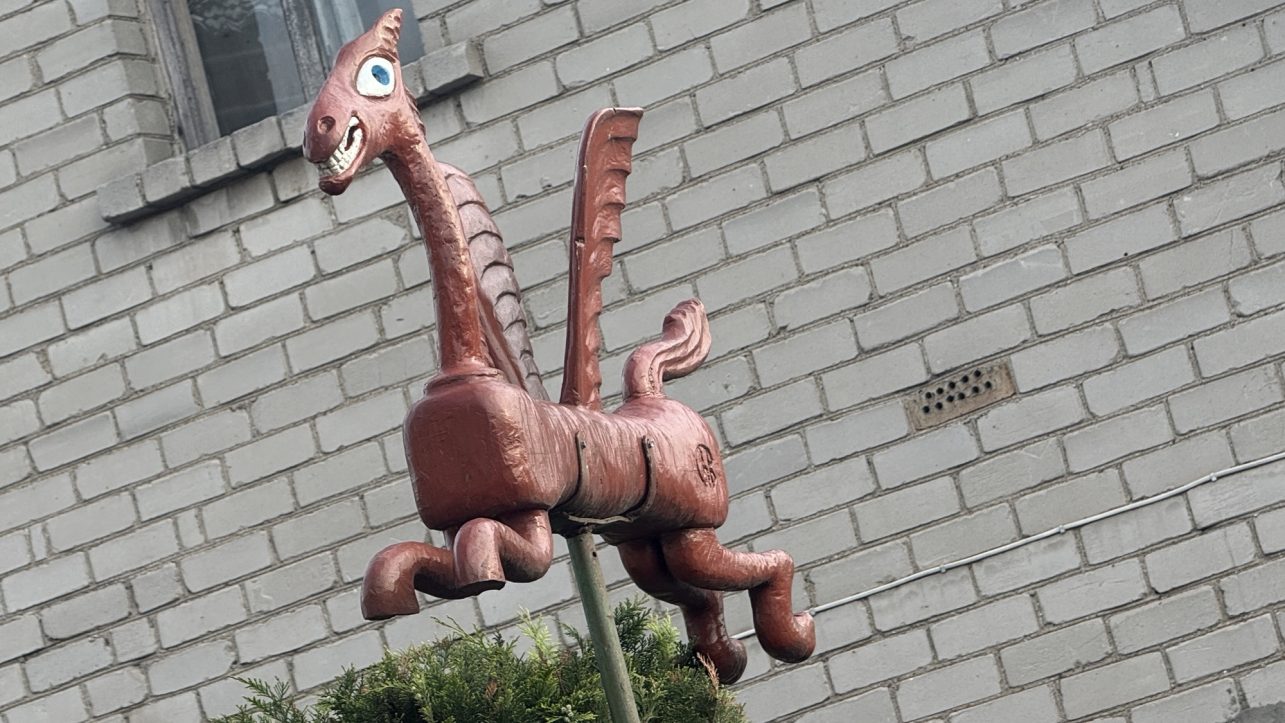
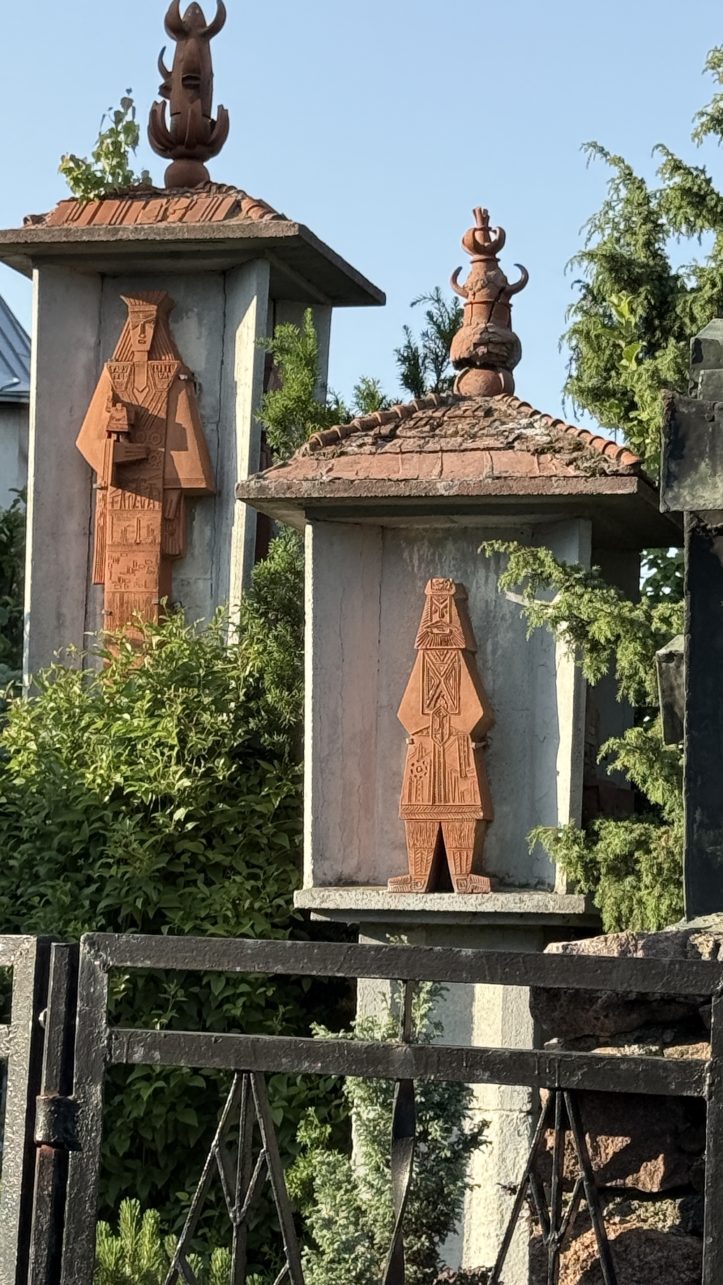
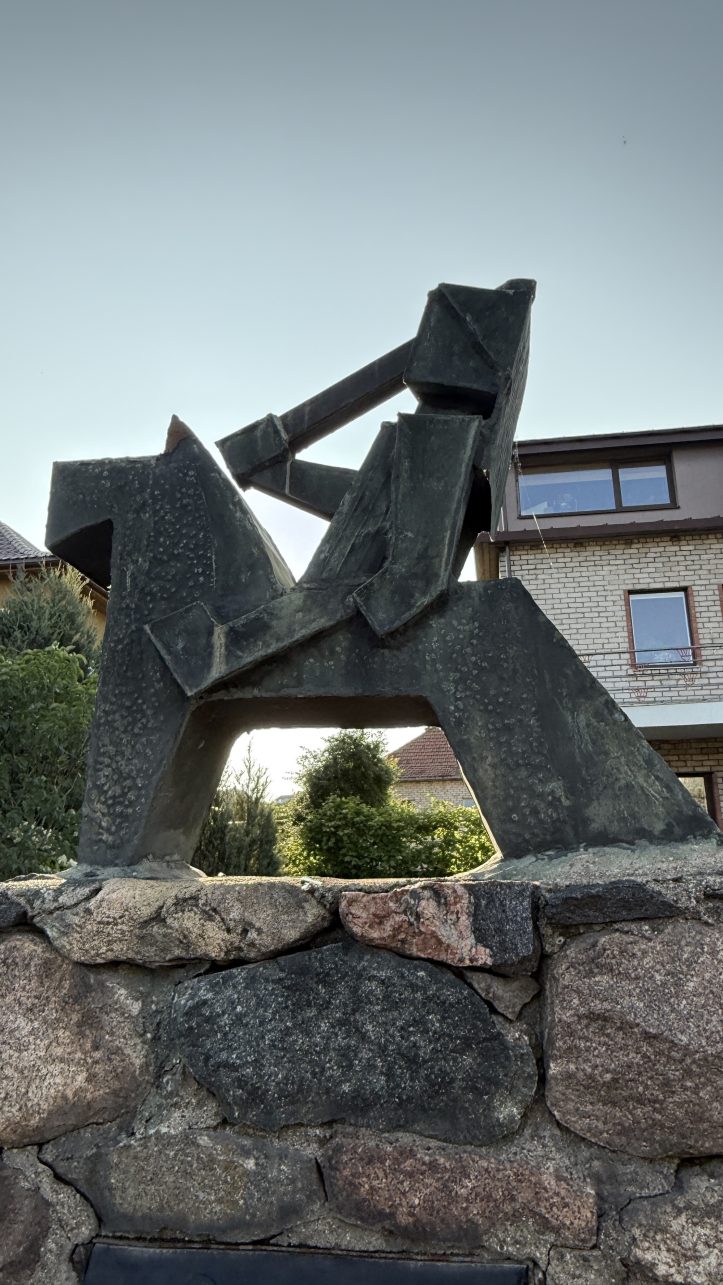
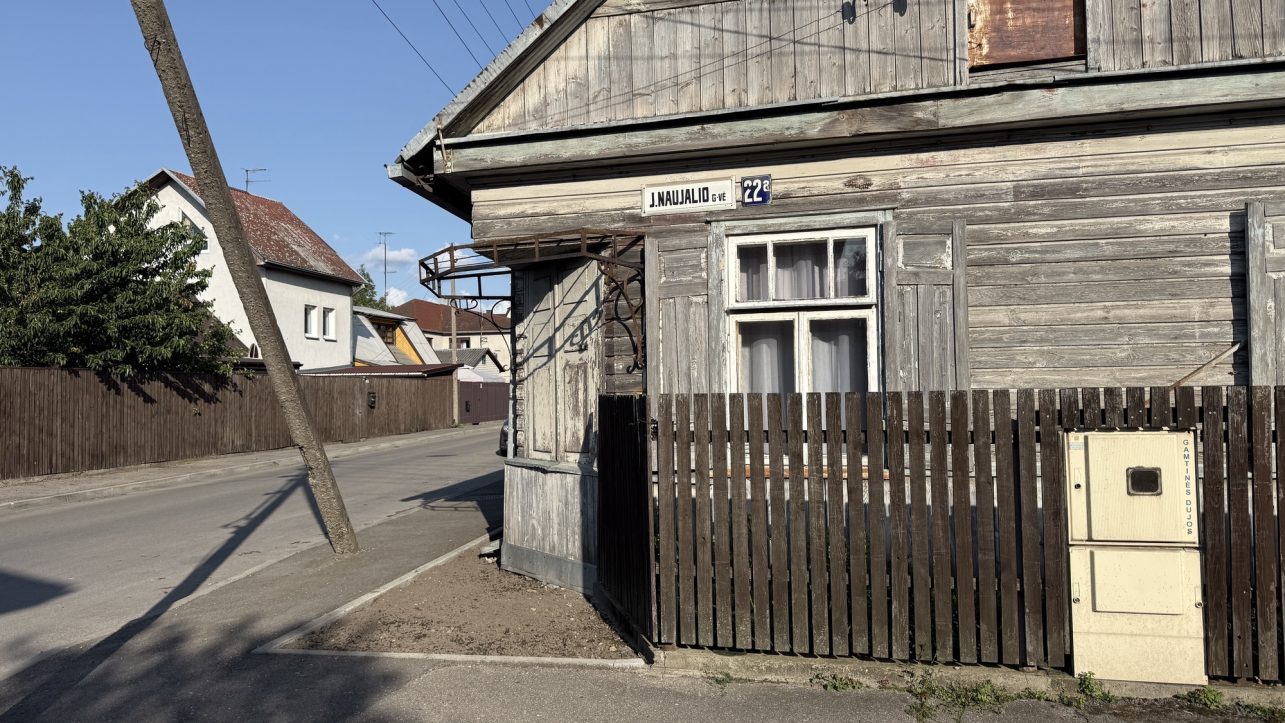
Going even further, turning from Panerių Street onto Kernavės and then onto J. Naujalio Street, you will approach the eatery Pas Jadvygą, where both students of the LSMU Veterinary Academy and LSMU Gymnasium enjoy their cepelinai. Figuratively speaking, over a decade ago and more, this was a popular coworking spot for “freelancers” from this part of Vilijampolė, sometimes mistaken for medical professionals. Perhaps this spot deserved a mention in the Gastronomy section after all?
Well wishes
Panerių Street holds enough content for more than just one walk, and this route – like all of Kaunas – can be explored through many different lenses. Along my way, I encountered several substantial commemorative plaques and maps dedicated to the memory of the Kaunas Ghetto. Still, for instance, Vytenis Jakas’ art installation Burning Stones at the beginning of Linkuva Street – mirror shards catching sunlight and the faces of passersby – serves as a much more powerful commemoration of history than the previously mentioned memorials. Here we should also mention the 11th Kaunas Biennial in 2017, titled There and Not There (Im)possibility of a Monument, curated by Paulina Pukytė. Jenny Kagan, the daughter of a couple who met in the Kaunas ghetto, who participated in the Biennial and later created several memorable works in Kaunas, offered customers in her shop in Demokratų Square bags, which divided them into “left” and “right” – just like the participants of the Great Action.
So first, I would wish the residents of Panerių Street – many of whom settled here after the original inhabitants were gone – to have more historical sensitivity. The second, somewhat lighter wish is for the residents of all Vilijampolė as well as other Kaunas locals to find a fun way to commemorate the fact that Milikonių Hill will be closed to traffic this summer. Although, as you’ve probably gathered from this article, most Panerių Street residents have their own yards where they can barbecue and enjoy summer in other ways, a car-free street is still a great excuse for a community celebration. Maybe you remember the Flash Voyage concert on the closed Petras Vileišis Bridge? That’s roughly what I’m talking about.
P. S. Maybe not this year, but smoother sidewalks would definitely encourage closer community interaction.
